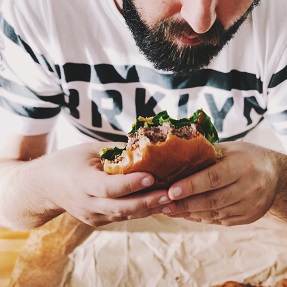
These two common eating habits blamed for excess weight gain
A small but telling study has found two common eating habits you may be doing leading to piling on of pounds – eating too fast and eating bigger bites of food. While this finding may seem insignificant and not that surprising, it also has implications for linking the amount of food we eat to how healthy we are and the effect on weight gain. With obesity being one of the biggest health threats worldwide, the more lifestyle factors we can pinpoint as a potential risk factor for becoming overweight to obese helps in the fight against obesity.
The research, conducted at Pennsylvania State University, recruited 44 men and women ranging in age from 18 to 68. The participants met for a weekly lunch over the course of 4 weeks in which each was given various portion sizes of macaroni and cheese, served with water. As the participants ate, they were videotaped to help researchers assess how fast each participant ate and how big of a bite of food they took.
What the study found was that when the participants were given 75% larger portion sizes of macaroni and cheese for lunch, they ate as much as 43% more of the meal than smaller portions sizes provided.
The study also found that the speed of eating didn’t change with bigger portion sizes. Rather, participants who either ate fast or took larger bites with each forkful ate more food overall.
Problems of eating too fast and taking bigger bites
These findings remind us that in our busy world, it’s not unusual for us to eat quickly and in a hurry. However, when we eat fast, it’s much easier to eat a lot more food than our bodies really need. Overtime, excess caloric intake can lead to weight gain. It takes the brain about 20 minutes to realize that you’ve had enough to eat which is why fast eating is associated with overeating.
Eating fast not only increases the risk of becoming overweight or obese but it’s also linked to other health problems, including:
- Insulin resistance – Characterized by high blood sugar and insulin levels, eating fast is linked to insulin resistance.
- Type 2 diabetes – A 2013 study found that those who gobble up food quickly were 2.5 times more likely to develop type 2 diabetes compared to people who ate slowly.
- Metabolic syndrome – Eating rapidly may increase your risk of this syndrome which is a group of risk factors raising the risk of diabetes and heart disease.
- Poor digestion – The consequence of taking larger bites and eating too quickly can affect digestion leading to bloating, gassiness, and cramps.
Since eating quickly has several negative consequences associated with it, here are some tips helping slow down your eating:
- Put your fork down between bites
- Avoid eating watching TV or using any electronic device. This can lead to mindless eating and eating too fast.
- Eat regular, consistent meals each day to avoid getting overly hungry that can cause eating quickly and making poor food choices.
- Drink water throughout your meals helping you feel fuller and to help slow down eating.
- Chew each bite thoroughly before swallowing.
- Eat foods high in fiber, like fruits and vegetables that take longer to chew and are filling.
- Take small bites to slow down eating pace.
- Eat mindfully paying attention to your food learning to enjoy it more.
Now, let’s take a look at large portion sizes. Over the past 25 years, restaurant portion sizes in American have grown substantially. Many of us have grown accustomed to these overly large portions sizes that most of us have no idea what a proper amount of food to be eating should look like.
The problem is that eating even just 100 extra calories each day for a year will result in a 10 pound weight gain. Keep in mind too, that the serving size shown on Nutrition Facts labels on food packages is not how much you should be eating but are based on what people actually do eat. In other words, the serving sizes shown are not a “one size fits all” kind of recommendation for everyone.
To help curb eating large portion sizes of food that simply add on more calories than what you need at the end of the day, here are a couple of helpful hints:
- Do a reality check of how much food you really eat at each meal. For example, when pouring cereal into a bowl, pour it back into a measuring cup. What you thought was 1 cup might actually be 3 cups, especially when using a large bowl.
- Learn to listen to your body when eating. Start with a modest portion size of food on a small plate and when finished, wait for 20 minutes doing other things. If you get to 20 minutes and your stomach is growling, have a few more bites. If you feel satisfied, then you took the right amount of food your body needed.
- Use smaller plates for meals and deliberately practice taking smaller bites when eating.
